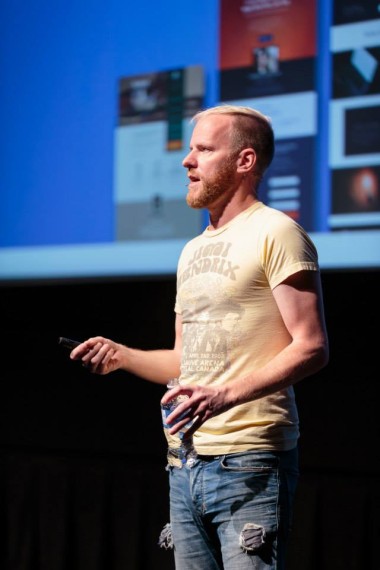Editor Note: Eric was given a press pass by Unbounce to attend the event. No other compensation or agreements were offered and coverage was not guaranteed.
I attended the last leg of “The Conversion Road Show,” put on by the landing page conversion and optimization company Unbounce, in Boston on June 8th, 2015. This is the first conference series by Unbounce, and by many measures it was a big success. The conferences were sold out in all cities: New York, Toronto, Chicago, and Boston.
The Boston conference packed a lot of speakers into an 11:30 AM- 5:30 PM schedule with more than 150 people in attendance.
The number one takeaway from speakers in Boston was less is better. Minimalist website design caught on like wild-fire in the past two years and is equally prevalent in the world of conversion rate optimization (CRO). The KISS principle (Keep it Simple Stupid) is very alive and very well in the world of CRO.
 Unbounce Co-Founder, Oli Gardner
Unbounce Co-Founder, Oli GardnerOli Gardner, Ubounce C0-Founder on CRO Design Tactics
First to speak in Boston was Oli Gardner, Unbounce Co-Founder. He says he’s “seen more landing pages than anyone on the planet”. He’s only been speaking at conferences for a little over a year, and attendee sentiment matched mine: Do not miss a chance to hear him present.
Oli is all about focusing on clarity with CRO design tactics. He’s incredulous that so much poorly constructed communication gets spread widely. He used a riotous example of misunderstood communication by playing pieces of famous songs where lyrics are easy to misinterpret. Clearly, many mega-star musicians do a poor job getting feedback before they release their art:
- Sparing his wife from his warm sausage tea is actually “Spare him his life from this monstrosity!” – Queen
- Hold me closer Tony Danza – is“Hold me closer, tiny dancer.” – Elton John
- It’s a death row hard-on two minutes too late is “It’s a death row pardon two minutes too late” – Alanis Morissette
Oli also noted that Qualaroo is a great tool for website surveys that provide customer feedback, and most people gravitate towards people’s faces and where a person is looking. He stressed the importance of using photos with people looking at the key page call to action component.
I sat down with Oli after the conference and asked him how practices for earned media versus paid media differ. He pointed out that organic traffic is usually less measurable.
For example, landing pages should not be indexed with search engines since it skews the rich data we get with highly targeted paid campaigns. He also stressed different landing pages need to be created for different channels—for example, a more conversational tone should be used for email.
Larry Kim, Co-Founder of Wordstream: “The Game of CRO: 5 Incredible CRO Hacks That Boost Conversions by 3-5x”
Larry said A/B testing is over-rated which caused a hush to pass through the room. He quickly moved to explain the problem is because marketers over-simplify data results. Done correctly, split testing is of course very powerful. However, what worked last month now faces new variables that could change effects. He emphasized what many of us believed, but didn’t the data to confirm: click-to-call is a tremendous winner for companies, and produces a 3% average conversion rate for landing pages.
In addition, we need to focus on the new, more precise ways of qualifying visitors for paid media spends. Google shopping ads is a great example. Image, description, and price are displayed in the same format for all advertisements before someone clicks. Shopping ads get 3-5x more clicks than text ads in part because people like to click near images and the price is clear.
[pullquote]“96% of people who visit a website leave without completing the actions marketers want them to take.”[/pullquote]
One of his key takeaway’s was “Bigger changes produce bigger changes.” This was a fantastic point that is central to our innovation culture. “If it ain’t broke, don’t try to fix it,” might be another way of saying change isn’t good. But, it’s actually at the core of our digital media industry.
Michael Aagaard, Founder of Content Verve: “How To Write Copy That Converts: Actionable Insights From 6 Years of Testing”
According to Michael, there are two types of thinking, System One, which is intuitive, and System Two, which is analytical.
System One lets people make snap judgments and is more common. System One is the easy, “ahh” experience and System Two kicks in when we have an “arghhh” experience. Don’t make prospects or customers worry about filling in all complexities of the big picture. Michael suggests this may force them to strain their thought process when the process could be frictionless.
According to his presentation, Michael says we do want to engage both the analytical and creative process. He’s not promoting simplistic is better than complex, but insisting we should think about what can cause dissonance for a customer’s thought process.
Ellie Mirman, VP Marketing of Toast: “Big Wins From the Inbox: Email Strategies to Get More Conversions.”
Ellie thinks email marketing is alive and well, in spite of the many naysayers saying it’s dead. I tend to agree.
She has noticed that simple changes tend to make the biggest differences. In her case study, email with a single call to action increased clicks 371% and sales 1617% over multiple calls to action.
For the best results, she suggests focusing on the message more than on overly complex list segmentation, 25% of which will expire after a year. Instead, run big and wide-ranging tests. Test many email variables, such as time sent, and dates, not just subject lines.
Dan McGaw, Founder of Effin Amazing: “Back to the Basics: Conversion Optimization Process”
Dan’s biggest take away: You’ve got to fail to learn from testing. Don’t be afraid! Google Analytics is not ideal for following individual identities: go with Kissmetrics or Mixpanel if this matters to you. Find where people are dropping from your website and push Q&As to users on those pages.
He also stated that photo choices should be tested once you’ve done more basic testing on graphic elements like buttons. Multivariate testing is super powerful, but research whether you have enough data to implement: you’ll need a lot for meaningful results.
Slide Decks for John Bonini & Chris Savage
You can view slidedecks for the final two speakers of the day John Bonini, Marketing Director IMPACT and Chris Savage, CEO Wistia.
Final Thoughts
What is it with digital marketing software companies and their ability to get such widely positive feedback from attendees? This was my fourth such conference in two years (the others were Exact Targets’ Social Media Domination, Hubspot’s INBOUND, and Conductor’s C3), and suspicions of spiked Kool-aid (or coffee) during breaks were gnawing at me the next day in Boston.
However, the fact is companies with highly satisfied customers and employees can produce the most successful conferences. People feed on each others’ positive feelings in large groups. There were plenty of smiles to go around in Theatre 1 at The Revere Hotel last week.
All images are from Unbounce.




